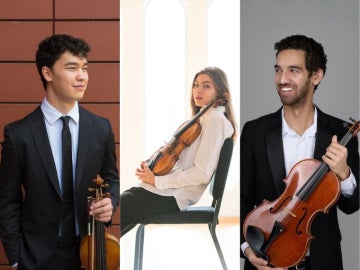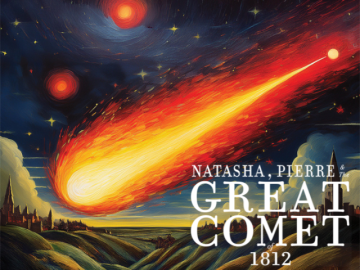Oberlin Conservatory Implements Innovative Approach to Music Theory Teaching
Expanded offerings build a wider variety of analytical skills, with enhanced opportunities for specialized study.
December 20, 2021
Erich Burnett

Professor Jan Miyake leads a music theory class in a Bibbins Hall classroom at Oberlin.
Photo credit: Tanya Rosen-Jones '97
Oberlin Conservatory’s legacy of music theory pedagogy dates to the 19th century, and its faculty in the decades that followed authored numerous textbooks on the subject.
Over the past 150 years, approaches to teaching music theory at Oberlin have experienced a subtle and ongoing evolution, including changes in the music used for teaching and the skills students have been challenged to acquire.
Today, Oberlin graduates go on to perform a wider range of music than ever before. And change is needed once again.
Beginning in fall 2021, Oberlin implemented a revised curriculum that significantly broadens the scope of music studied by first-year theory students. The transition aligns with contemporary conversations among music theory scholars, but represents a significant departure from traditional music theory education across North America.
In particular, the focus of the conservatory’s first-year theory courses has expanded, from a longtime emphasis on musical concepts of harmony and phrase as they apply to Western classical music, and toward a more wide-ranging application of concepts such as rhythm, meter, timbre, and texture as they apply to everything from film music to popular and global musical styles.
The study of music theory revolves around concepts and compositional structures involved in creating music, as well as examination of music’s impact on the listener. Until now, very little of the curriculum had evolved with the evolution of music itself.
“We have been teaching—and all conservatories are still teaching—the curriculum we inherited from the 19th-century conservatory,” says Megan Kaes Long, an associate professor of music theory and one of numerous faculty architects of the division’s new emphasis.
At Oberlin, the most recent substantive changes to the written theory curriculum happened in the mid-20th century. In 1956, newly adopted core classes included Music Theory I through IV—a structure that remained in effect until this year. Soon after that revision of some 65 years ago, the music used in those theory classes changed: Oberlin’s faculty published yet more theory textbooks that incorporated what they felt was the best material for promoting musicianship—real music by recognized composers, rather than artificial exercises developed by theorists.
“Our field is changing, and for very good reasons,” says Long. “The music our students will be performing is not the same music our previously constructed curriculum was created to address.”
Put another way: Music students everywhere have been trained to learn their craft solely through the prism of those who created it long ago and from a relatively limited perspective: that of the Western European composer of the 17th through 19th centuries. The new approach aims not to erase the innumerable contributions of those composers, but to free up space for the exploration of a wider variety of repertoire, styles, composers, and movements.
“What we’ve been training our students to do for so many years is to become experts in Austro-German music, but musicians today don’t just play German music,” says professor Jan Miyake, chair of Oberlin’s Division of Music Theory. “Decentering is a word we like to use. We’re trying to decenter the German canon to make room for other things.”
At Oberlin, extensive studies in music theory are a core component of every conservatory major, with each student taking a total of at least four semesters of theory and four semesters of aural skills. Collectively, these courses deepen students’ understanding of how music is constructed and foster more meaningful engagement. The goal is to send graduates into the world with a more practical understanding of how to apply these concepts in their musical lives and to the variety of styles in which they may perform.
“The reenvisioning of the music theory curriculum is part of a suite of efforts underway in the conservatory to broaden the aesthetic priorities represented in school,” says Dean of the Consevatory William Quillen. "These efforts align with strategic work underway across campus, including the Presidential Initiative on Racial Equity and Diversity, One Oberlin, and more. Through this work, we’re looking to widen the cultural aperture of the school—in the classroom, on the stage, and more—further expand the range of opportunities available to our students, and further support them to thrive—creatively, intellectually, and personally—as artists and citizens in the 21st century.”
As in past years, conservatory students who arrive at Oberlin with experience in music theory may elect to complete a placement test to opt out of the conservatory’s entry-level theory course (titled MUTH 120 in the Oberlin course catalog). Unlike in past years, all conservatory students are required to complete both Introduction to Musical Analysis (MUTH 131) and Deepening Musical Understanding (MUTH 132).
In their second year, all conservatory students complete two additional specialized theory courses at the 200 level. One of those courses is required to focus on analysis of post-tonal music, which began to emerge in the late 19th century. The new 200-level curriculum also accommodates greatly expanded opportunities for exploration of topics aligned with students’ individual interests and career goals.
Beyond the required two years of music theory study, students will have access to a broad range of music theory courses at the 300 level and above, which may be required as part of their major or taken as part of a minor in music theory or as free electives.
This significant change in approach also extends to students in Jazz Studies, who take the standard sequence of four music theory courses, as well as two additional courses in jazz theory, one of which satisfies a requirement for a 200-level course. The biggest differences lie in the practical application of what will be learned in those first-year theory courses, with their increased emphasis on jazz-centric concepts including hypermeter, form, groove, and swing. “This is a big benefit for jazz students, and one that frees up a bunch of opportunities for flexibility,” says Long.
Also new this year are additional resources to ensure that all students—regardless of their high school background in music theory—begin their Oberlin careers on relatively equal footing. The conservatory offers a summer course, called Music Theory Jumpstart, taught by music theory professor Joseph Lubben and available online through OC Global, the conservatory’s virtual learning platform. The course is offered free of charge for Oberlin Conservatory students, who often place out of entry-level studies after taking it.
“The interesting thing about music theory is it’s a fairly young discipline, and it’s been invested in a relatively small number of problems for a long time,” says Long. “And so you start digging into things that we’ve always taken for granted—like what do melodies do?—and you realize that no one has actually thought very deeply about this problem, and that when you start to think about it, it’s very, very interesting.
“I had to learn a lot to prepare for this curriculum,” she adds, “and I have a PhD in music theory!”
Oberlin Conservatory’s music theory curriculum revision continues the institution’s ongoing efforts to expand curricular diversity and support inclusion. Learn more about Oberlin's commitment in the Presidential Initiative on Racial Equity and Diversity and the conservatory’s Racial Equity and Diversity Action Plan.
You may also like…
Amy Lee Joins Oberlin Conservatory Faculty as Associate Professor of Violin
The renowned violinist and associate concertmaster of the Cleveland Orchestra brings extensive teaching and performing experience to Oberlin
Oberlin Students Selected for Prestigious New York String Orchestra Seminar
Directed by Oberlin artist in residence Jaime Laredo, intensive 10-day experience culminates in performances at famed Carnegie Hall.
"The Great Comet" Starts Something New
Oberlin Music Theater's inaugural production is a story of beginnings, which is a fitting theme for the first main stage performance of the Conservatory's newest program.

